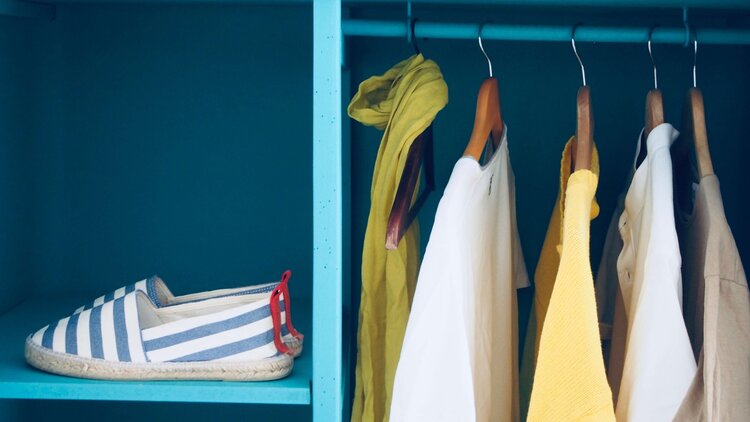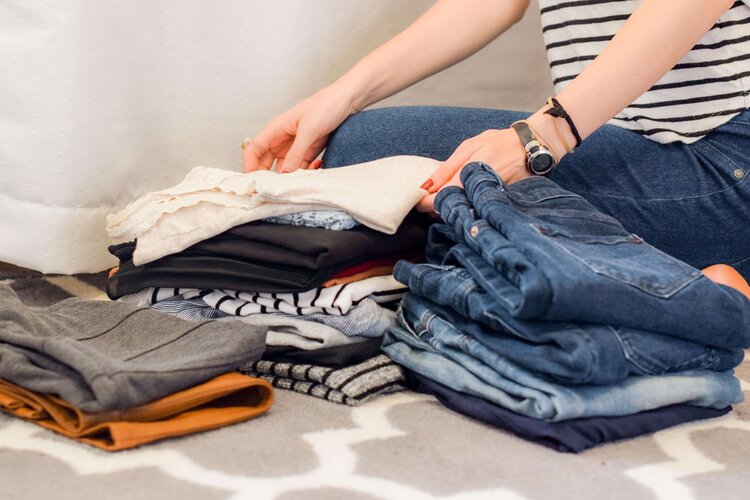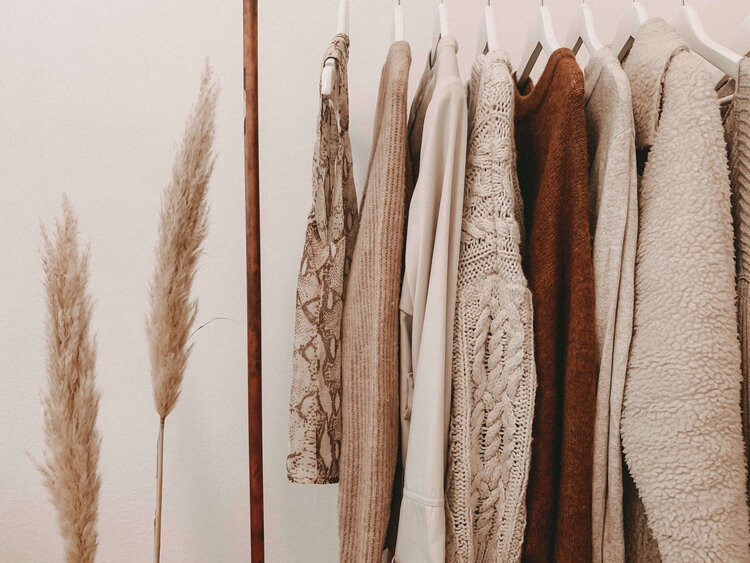Sustainable & Slow Fashion

Sustainable fashion, slow fashion – what does it all mean? It means a few things. Sustainable fashion addresses the environmental impact of producing garments, using sustainable raw materials and reducing waste throughout the process. Slow fashion is more of an overall approach to how you buy and wear your clothes – with a specific focus on purchasing better quality, longer lasting clothes. And it also encompasses the ideas of sustainability and fair treatment of the people and resources that go into making clothes. The terms are sometimes distinct – but are also sometimes used interchangeably.
My specific focus is the concept of slow fashion – and sometimes I like to think of it as simply slowing down. Slowing down to know what you already have in your closet. Slowing down to figure out what you like. Slowing down to take care of what you own. Slowing down when making purchasing decisions. In essence, it’s being more deliberate in every aspect of your wardrobe, from selection to storage to cleaning to disposing and beyond. It’s what I’ve been doing with clients for years, but to be honest, I never thought of it as slow fashion. But it’s what we all need to do to not only be mindful of how we deal with our clothes, but to begin to reduce the detrimental impact the fashion industry has on the environment.
I know – that sounds like a lofty goal. But as with most goals, it all starts with little steps. Because there are simple things you can do to minimize the impact your own clothes have on the environment and to be more purposeful in how you develop and maintain a wardrobe that makes you feel great, every day.
TAKE CARE OF YOUR CLOTHES
I talk about clothing care with clients all the time. And I most often frame it as honoring the investment that you’ve made in your wardrobe. But it’s also treating your clothes in a way that ensures they last as long as possible, so that you’re not buying replacements more often than needed.
Clothes care encompasses many things – but in essence, if you take care of your clothes, your clothes will take care of you. Put your clothes away when you get home, don’t throw them on the floor or leave them in a pile on the chair. Wear layers, so that your outer layers need less washing. Treat stains when you see them and spot clean as much as possible. Deal with torn seams and loose buttons as soon as you notice them, before they become a bigger problem. Treat your shoes with protectant sprays on a regular basis. Do what you can to extend the life of your clothes.
INVEST IN STYLES THAT LAST
I know you’ve heard it before – we all should focus on quality over quantity. But the quantity trap is an easy one to fall into. After all – in our society, we are given so many choices, so how can we choose just a few? But that’s precisely what we need to do. Because those four $20 blouses may look good on the hanger and last for several months, but the one $80 blouse should last quite a bit longer.
No, a higher price doesn’t always equal better quality – but I can almost guarantee that cheap clothes aren’t built to last. The world of ‘fast fashion’ has created a culture where it’s okay to spend less on something, because then you don’t feel so bad when it wears out quickly or you’re simply tired of it. The solution? Buy the best quality you can afford and avoid any purchase where the main reason you’re buying it is the low price.

BE TRUE TO YOUR LIKES
This is another thing I talk about a lot. Yes, trends come and go, and many people think that being ‘on trend’ equals being fashionable and stylish. But wearing what’s trendy is wearing what the fashion world says that you should like at this moment.
True personal style comes from knowing what works for you, knowing what you like and expressing yourself purposely through your clothes and accessories. It’s not about having the latest items in your wardrobe or wearing what’s hot off the runway. It’s about using your preferences as a filter in deciding what enters your closet. If the latest trend is something you love, then go for it! But if it’s something that’s not your taste, let the trend pass. That’s how you’ll build a long lasting wardrobe that you’ll love and enjoy for years to come – and you’ll avoid wanting to toss half of the contents of your closet every year. (If you’re looking to define or refine your style preferences, read this for the step you don’t want to skip.)
KNOW WHAT YOU OWN
I’ve been in hundreds of closets, which means I’ve seen tons of repeats in people’s wardrobes. You know what I mean – you look in your closet and suddenly realize that you have about five too many ivory blouses. Or that you could open a striped t-shirt store. Or conversely – you peek into the back of your closet and find a jacket that you totally forgot about.
Before you decide to bring more clothes in your closet, you need to know what’s already there, for a few reasons. To stop accidentally buying repeats of the same items. To understand what’s missing and keeping you from creating fun outfits. To ensure that you’re using what you already have. To shop strategically, so that what you buy enhances the functionality and overall style of your wardrobe. (Find out my 5 steps to a successful closet audit here.)
Basically, knowing what you own keeps you from making unnecessary purchases that support the cycle of buy and purge.

SHOP WITH INTENT
If you’ve read my blog before or attended my events, you’ve probably heard my analogy of equating clothing shopping to grocery shopping. It goes like this – when you’re food shopping, you most often have a list, right? But when you’re shopping for clothes, do you have a list? Most people don’t, and that’s a mistake.
A list ensures that you’re buying what you need, not just gravitating to what’s familiar. It’s essentially the next step after knowing what you own. Because when you know what you own, you can create the list of what you need, and shop with clear intent as to what you want to get that day. Which results in less items hanging in your closet six months later with the tags still on them, that didn’t fit your lifestyle or that you didn’t like that much after all. (Click here to read more tips to make shopping a productive experience.)
And here’s one thing I recommend if you find yourself going shopping a lot, but not necessarily accomplishing anything. The next time you think, “I have a free hour, I’ll go to the mall and look around” – take that hour, go into your closet and make some new outfits. Because if you’re like a lot of people, you devote much more time to shopping than to pulling together looks from what you already own. And creating outfits from what’s in your closet is not only eye-opening, it’s a lot of fun!
EXPAND YOUR IDEA OF SHOPPING
Shopping is going to stores, buying brand new things and taking them home, right? (Or ordering online, waiting a few days, and getting a fun box delivered to your door.) But that’s not the only option.
If you have an event that only comes up once in a while, how about renting an outfit? I’ve been in enough closets to know that you may have half a dozen cocktail dresses that you’ve only worn once or twice – but if you had rented these, you would have spent less money and avoided buying something that’s heading to the donate pile in the not too distant future. And an amazing side benefit of renting is that, with a smaller price tag and lesser commitment, you can be more adventurous and try something out of your comfort zone!
And if you have more expensive tastes than your budget allows, how about buying secondhand? There are so many avenues to shop gently worn clothes and accessories – from brick and mortar stores to online platforms to individual sellers. And the benefits are twofold – you get to enjoy the style and quality of items that may be out of reach at full retail, and you’re giving a second life to existing clothes.
If you’re looking to be more strategic with your wardrobe, discover the true holes in your closet and only buy what you need, click here to schedule a free consultation. We’ll chat about your challenges and create a plan so that you can feel great in what you’re wearing, every day.LET’S WORK TOGETHER!
Photos from Unsplash (top to bottom): Jordi Pujadas, Sarah Brown, Alyssa Strohmann
Paul Julch helps busy people to streamline, organize, and update their wardrobes so they can get dressed with ease and always look stylish and feel confident. Any budget, any lifestyle, any body. His business is Urbanite|Suburbanite, and he works with clients to develop a modern, current, versatile wardrobe that expresses personal style rather than trends. Paul is based in the SF Bay Area, and remote wardrobe & style coaching is available for out-of-towners. Visit Paul’s website http://urbsuburbstyle.com for more style advice, and follow him on Facebook www.facebook.com/UrbaniteSuburbanite/ , and Instagram www.instagram.com/urbsuburbstyle/ to stay up to date on the best styling tips and tricks.
